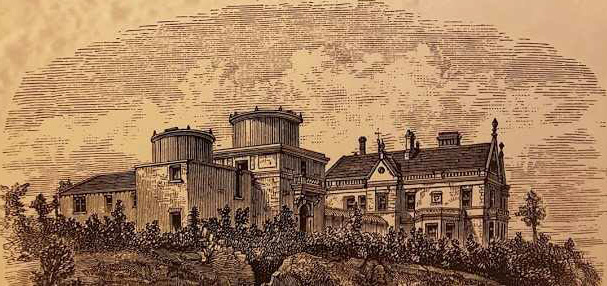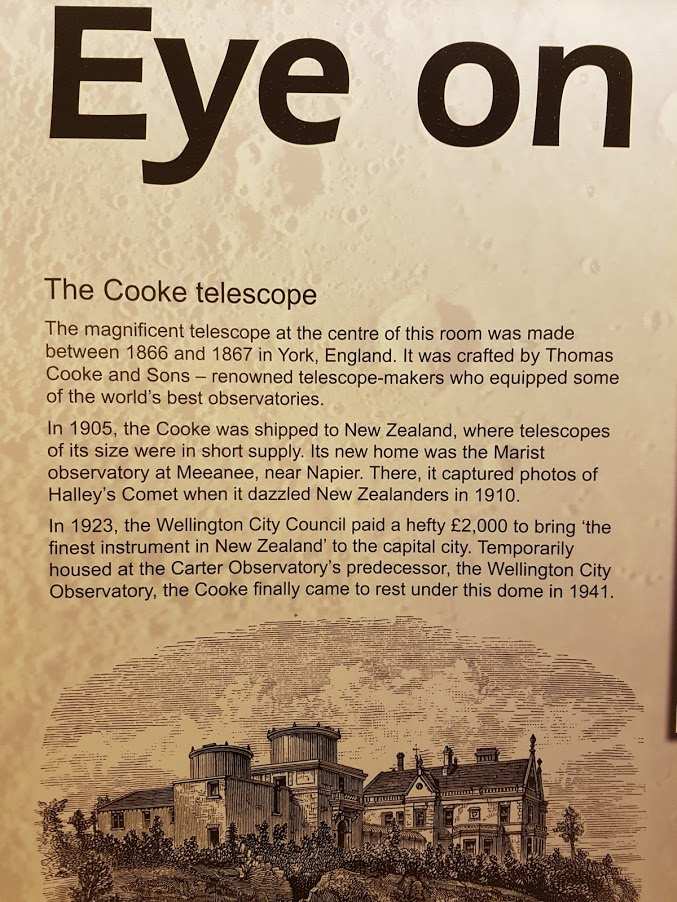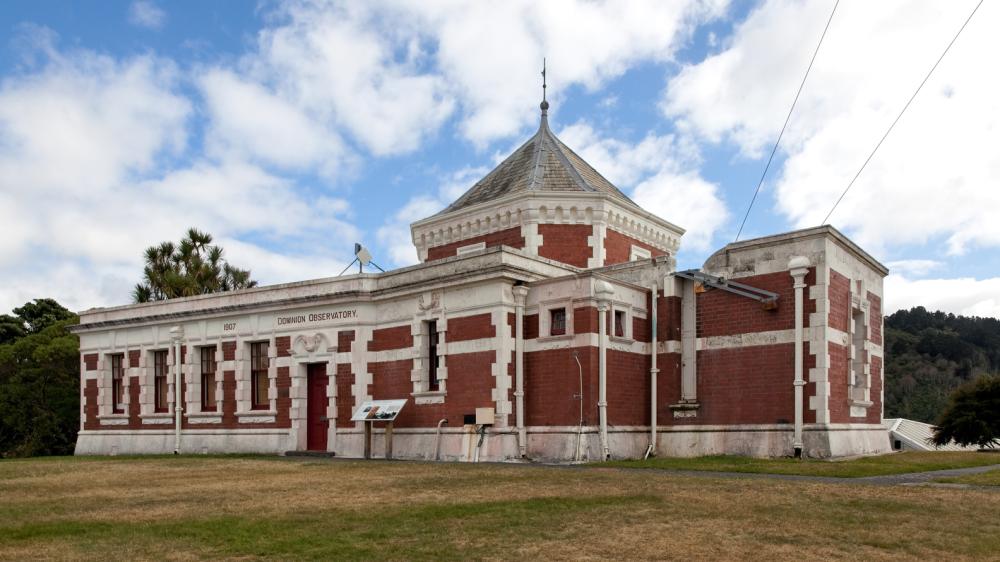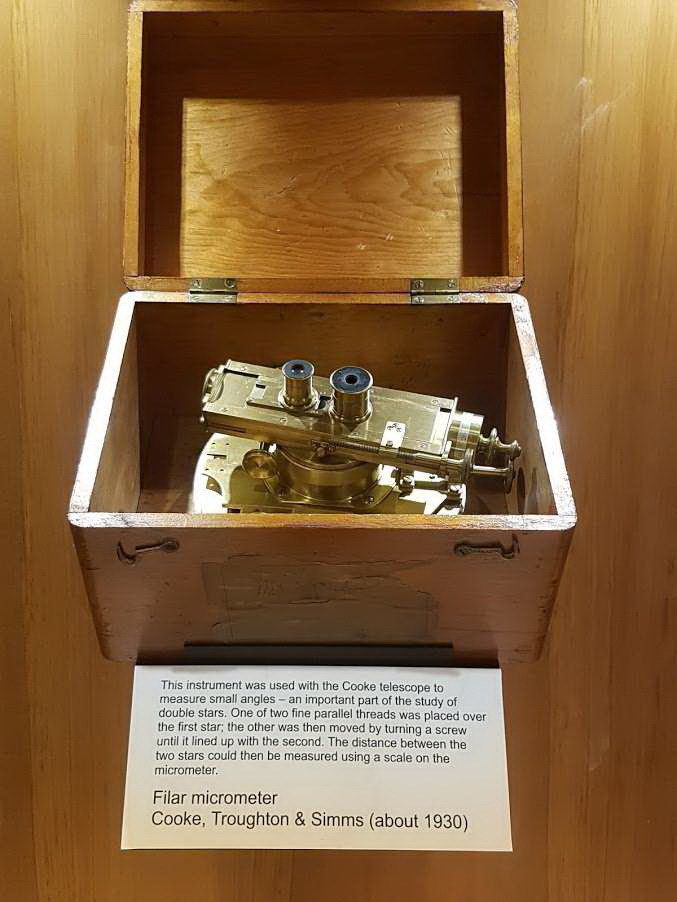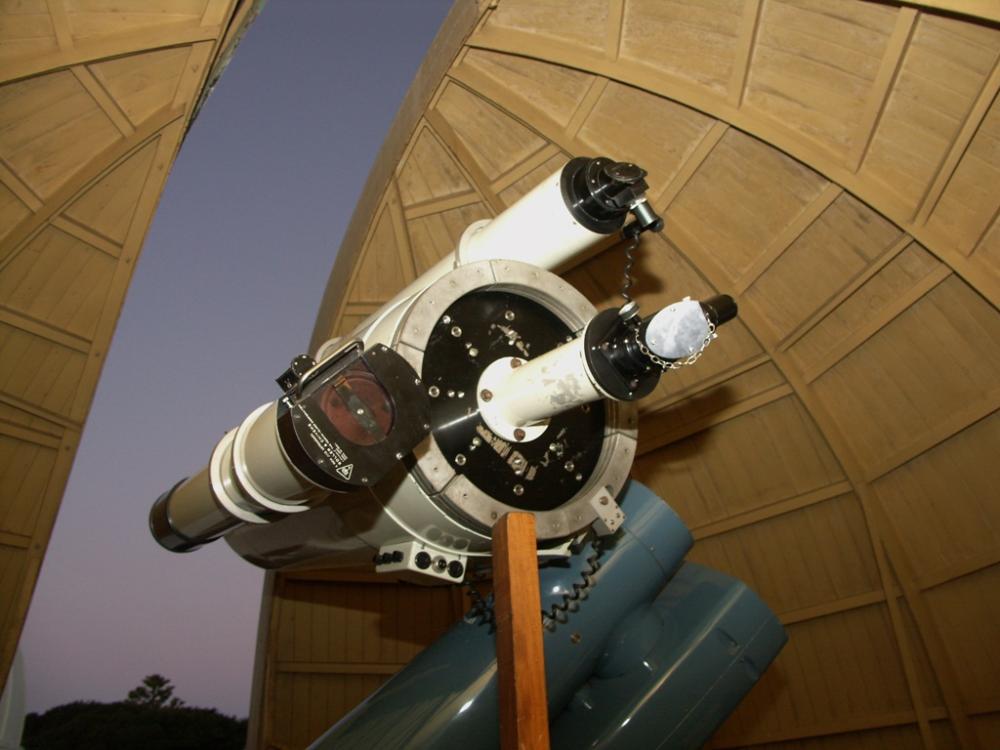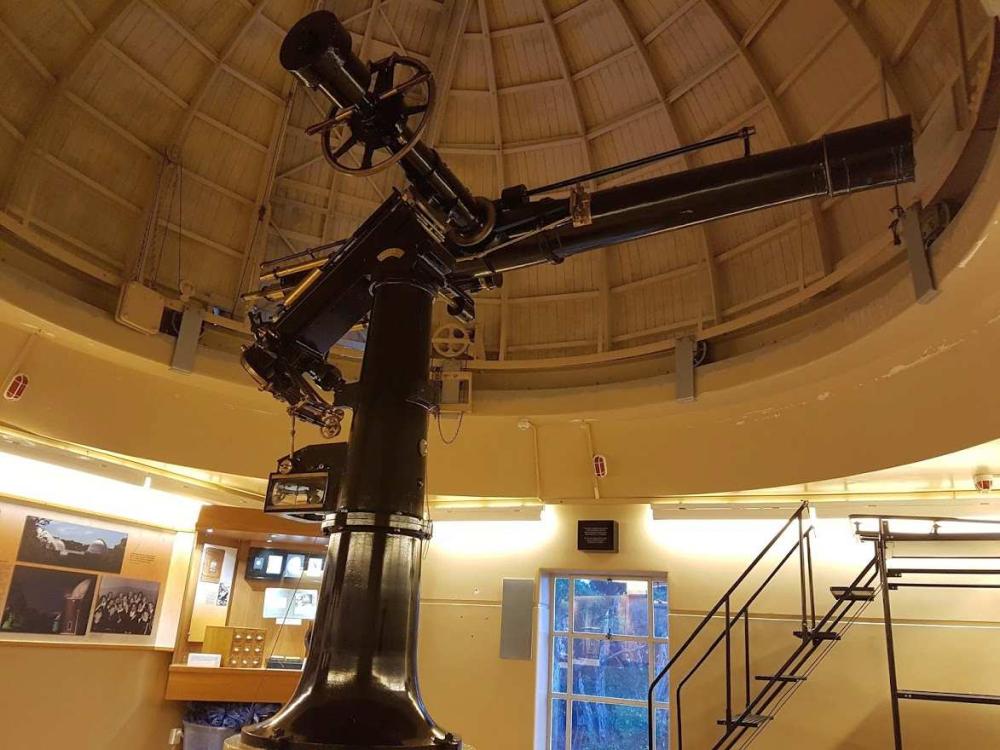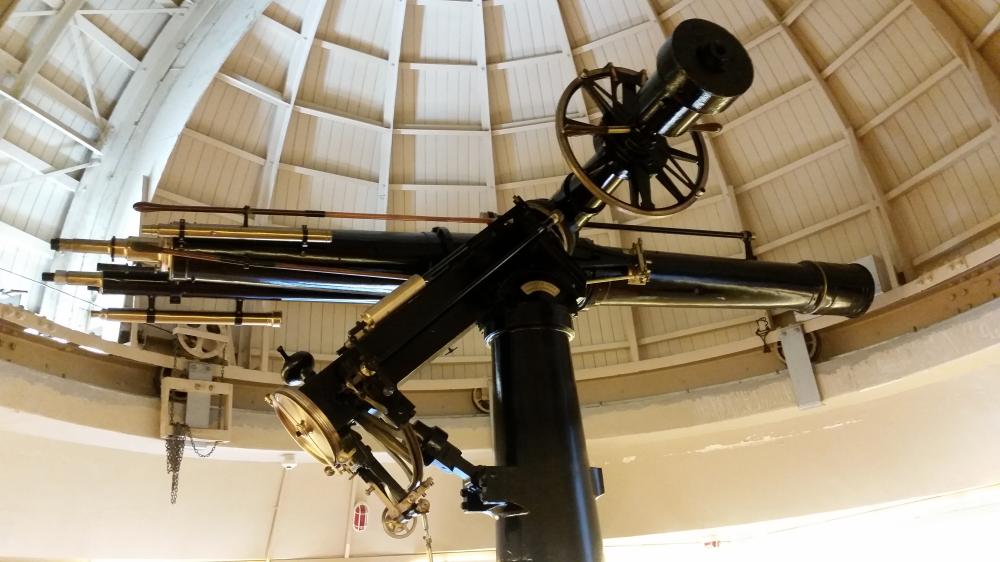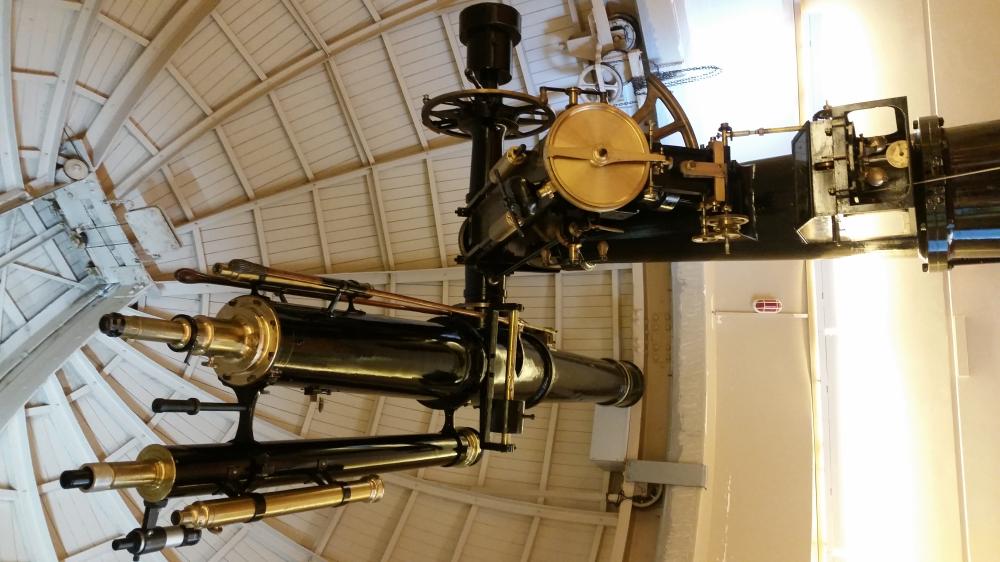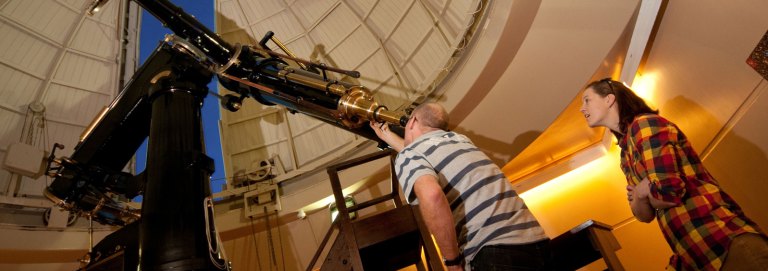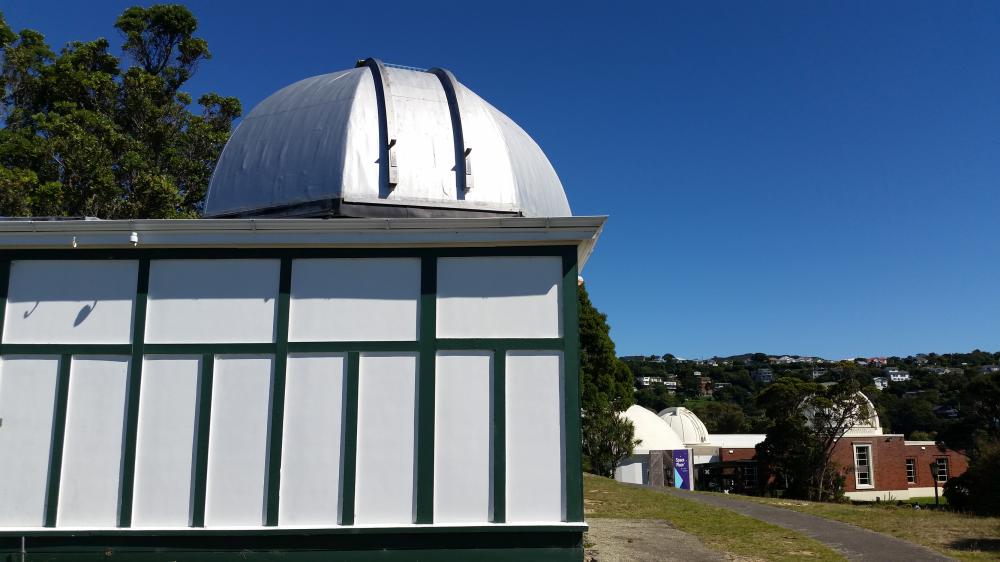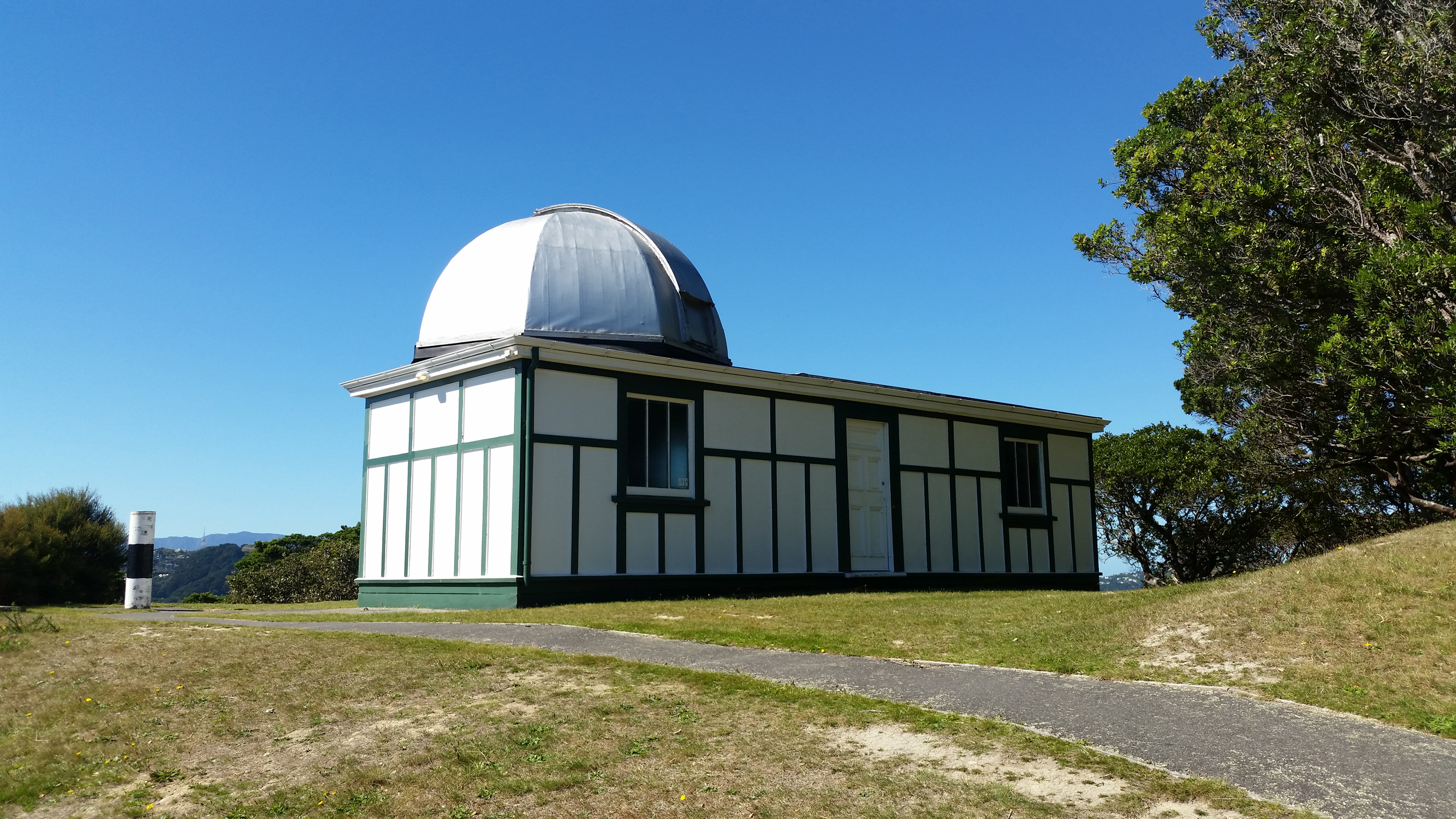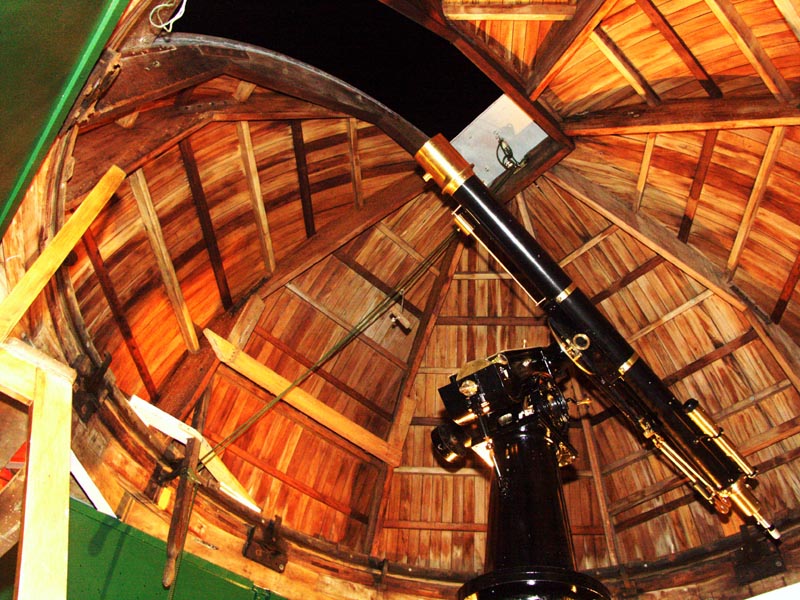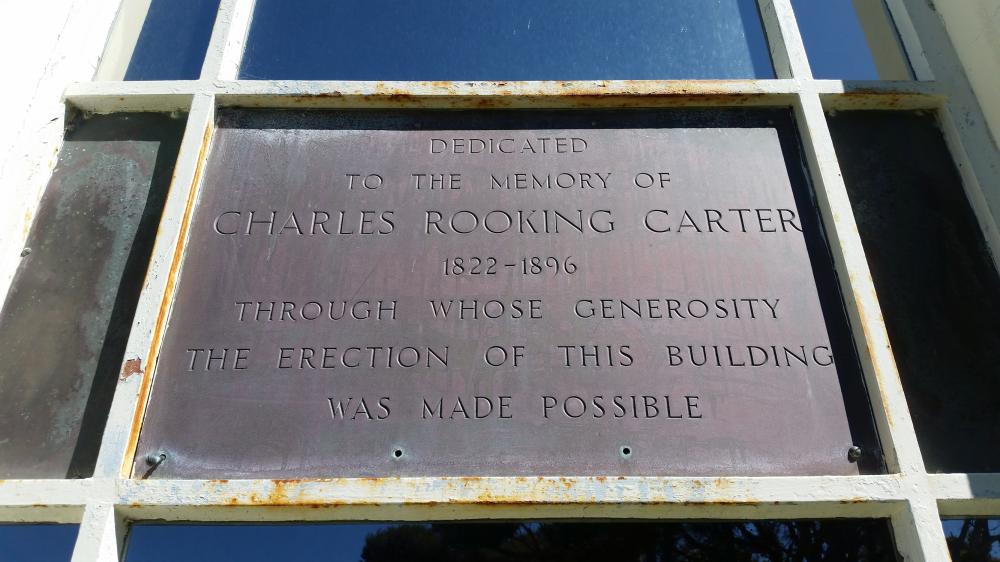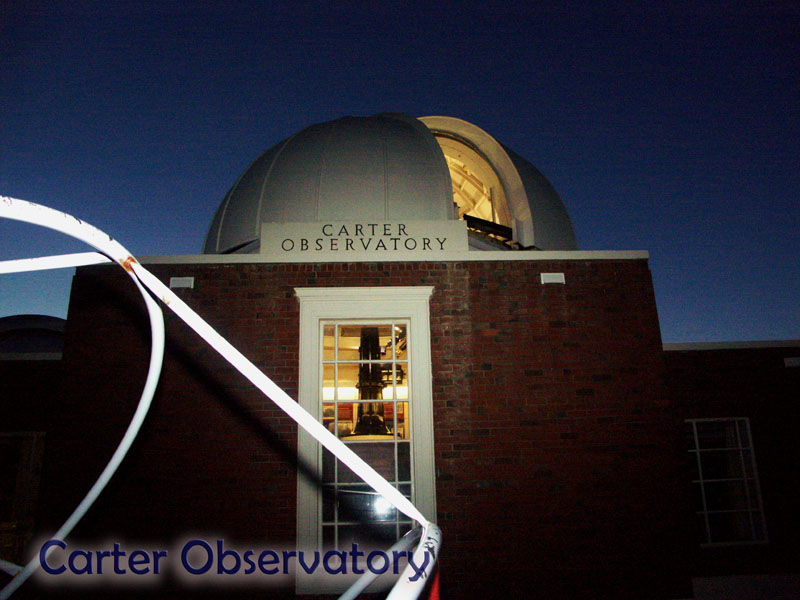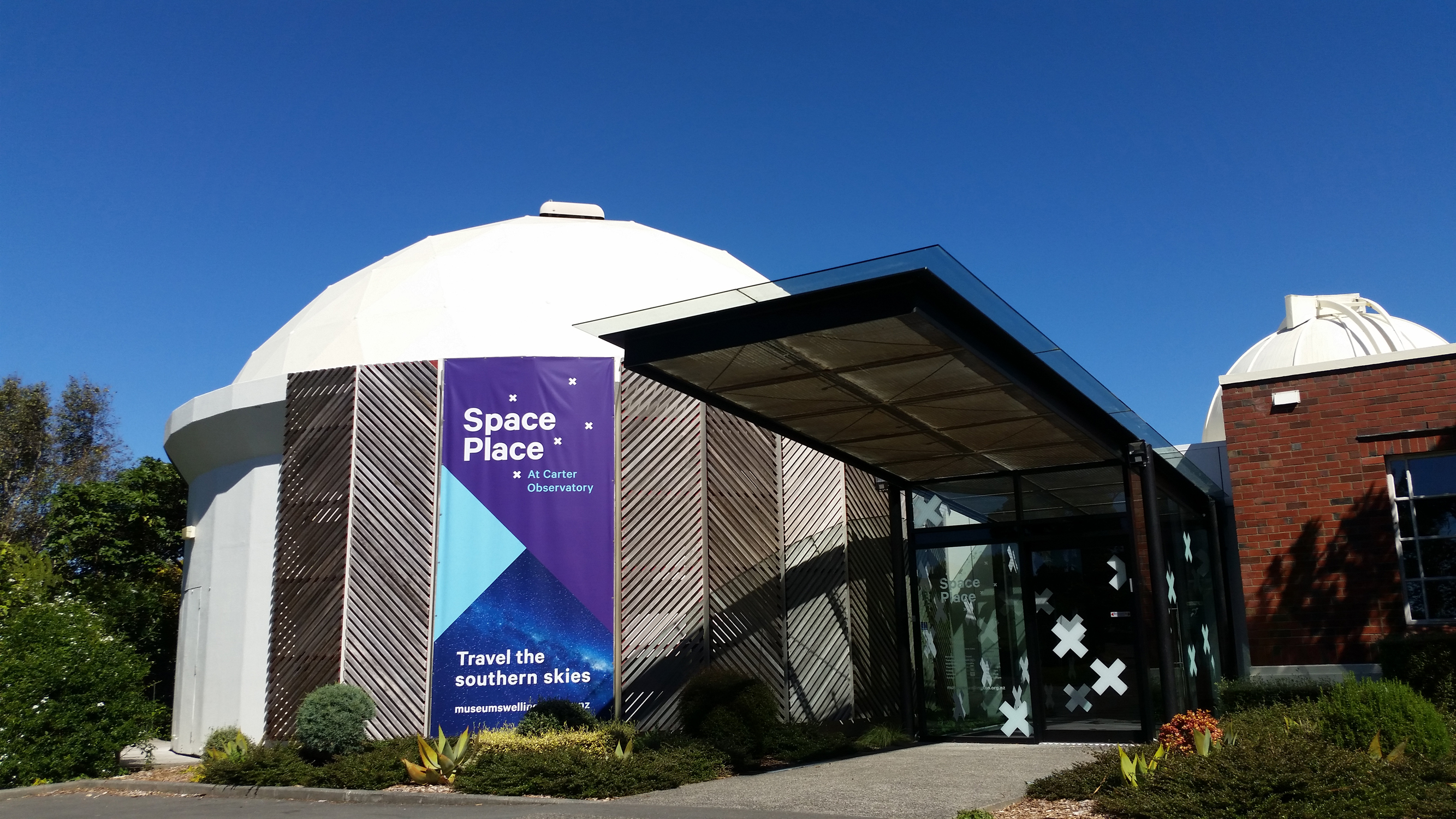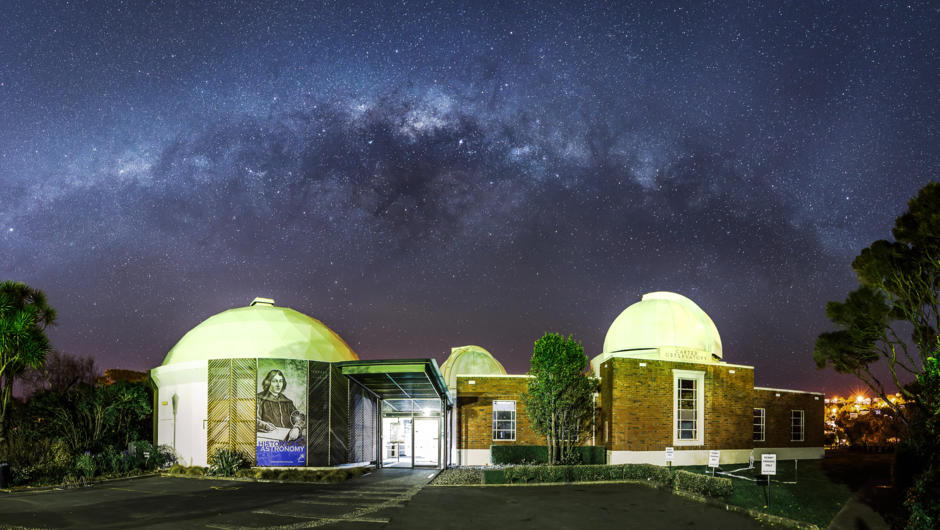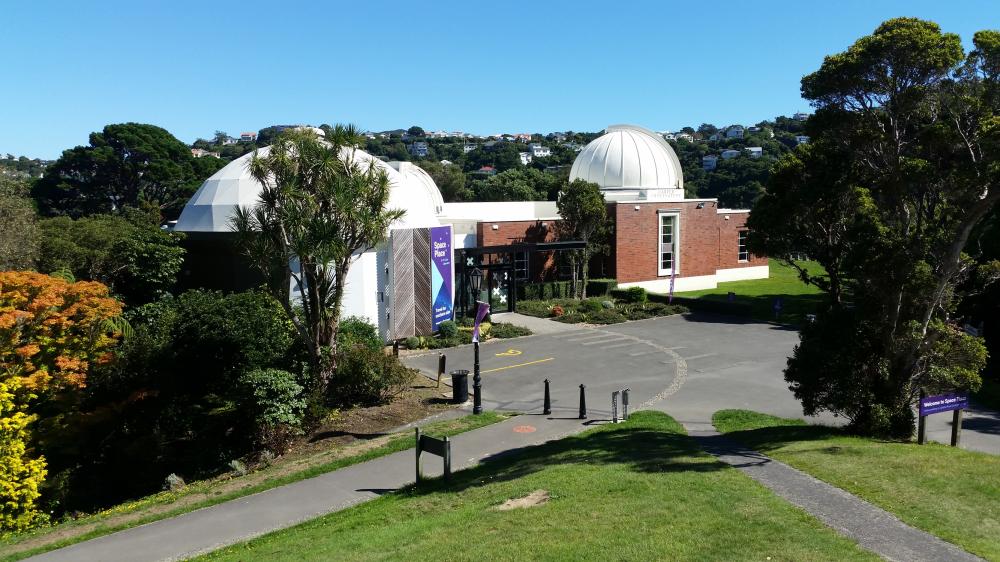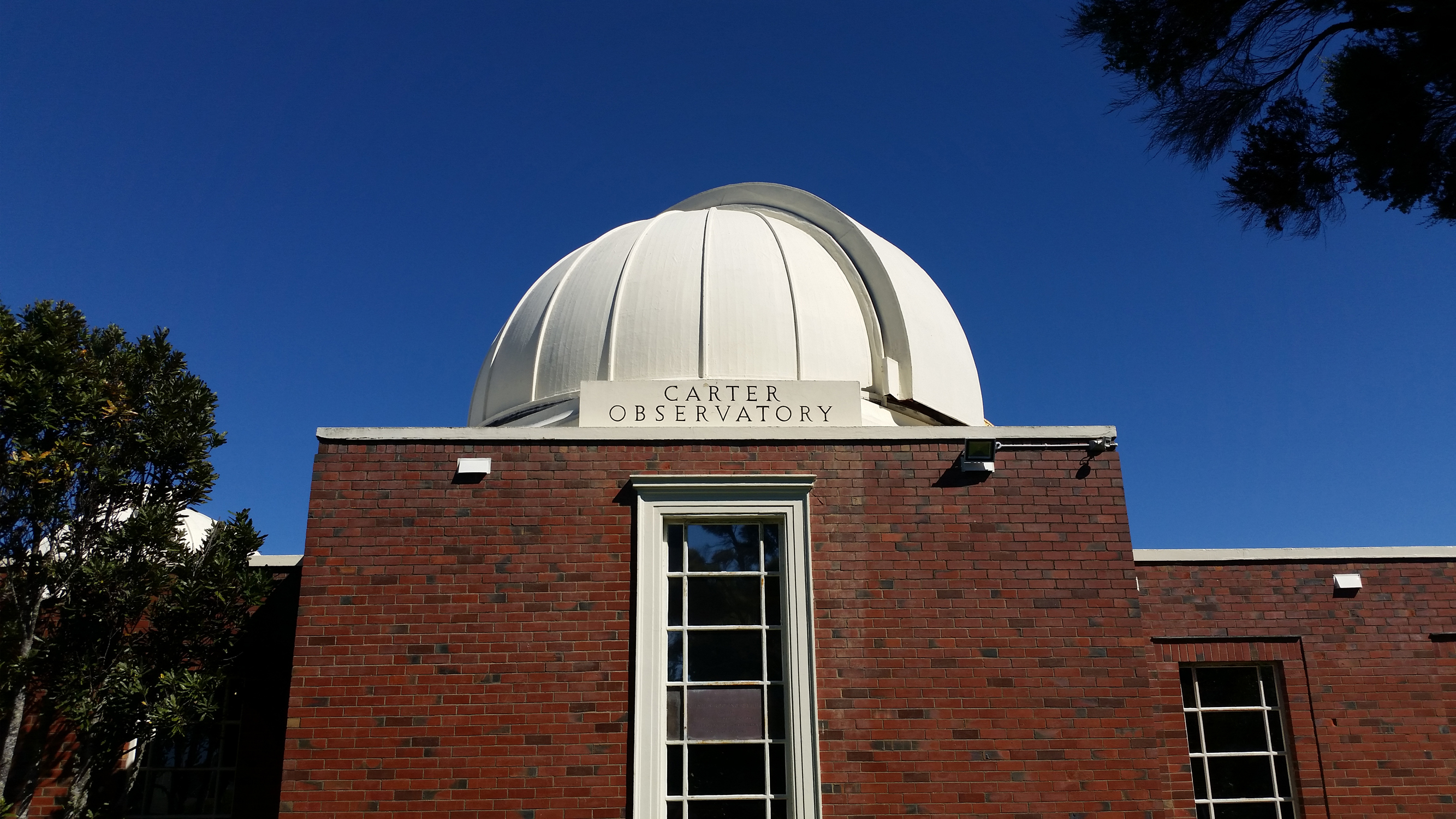
Category of Astronomical Heritage: tangible immovable
Carter Observatory, Wellington, New Zealand

Description
Geographical position
Space Place at Carter Observatory in the Botanic Garden,
40 Salamanca Rd, Kelburn, Wellington 6012, New Zealand
Location
Latitude 41°17'02.9'' S, Longitude 174°46'06'' E, Elevation 117m (384 ft) above mean sea level.
IAU observatory code
485
Description of (scientific/cultural/natural) heritage
Transit of Venus (1769, 1874 and 1882)
- Captain Cook was sent to the South Pacific by the Royal Society in 1769 to observe the Transit of Venus across the Sun in Tahiti, then he continued in New Zealand, observing the Transit of Mercury in the Coromandel Bay (hence Mercury Bay) -- these were the first scientific astronomical observations made in New Zealand.
- International observations made during the 1874 and 1882 Transits of Venus in New Zealand.
Early Observatories in Wellington
- Provincial Observatory (1863) for time-keeping, meteorology and climatology purposes. But the line of sight of the Provincial Observatory had soon been obstructed by the building of a new telegraph office (1869).
- Colonial Time Service Observatory (1868) in the Bolton Street Cemetery in Wellington, run by Reverend Arthur Stock, designed by architect John Campbell in the Edwardian Baroque. style.
The task of the Colonial Observatory was to determine the exact time Standard New Zealand Time by measuring the transit of stars. Instruments: a transit telescope, two clocks, a time-ball, which was dropped at noon.
The Colonial Observatory was demolished in 1906 (in 2003 it was refurbished by the Department of Conservation).
- Thomas King (public) Observatory (1917), (Maori: Ataira Te Ao Nui), amateur astronomer Thomas King (1858--1916), observing from 1887 to 1911. Telescopes:
- 12.5cm (5-inch) Thomas King Refractor, made by Grubb, Dublin (1882) used for public viewing of the Sun with a H-alpha filter (refurbished in 2001)
- 14cm (5.5-inch) Thomas Cooke Refractor.
The Thomas King Observatory is today part of the Carter Observatory, and the 5-inch is mounted to the Cooke Refractor. - Dominion Observatory (1907), Rawhiti Terrace, Kelburn, in the Botanic Gardens in Wellington, was used for the Government Time Service. Originally it was named Hector Observatory after Sir James Hector (1834--1907), Director of the Time Service 1869 to 1903, and 'Father' of New Zealand science, Director of the Colonial Museum, Colonial Laboratory, Colonial Botanic Gardens and Metrological Survey.
In 1925, the Hector Observatory was renamed to Dominion Observatory.
The Dominion (Hector) Observatory was designed by the architect John Campbell (1857--1942) in the Edwardian Baroque style. The building had a transit room (the meridian slit is visible in front of the building), an octagonal clock room and an office above it, forming the tower. Four offices were added to the western side of the building in 1926. The observatory was built on the grounds of the old fortifications of 1884-86; thus, it was suitable for recording seismological activities. - Wellington City Observatory (1924), nicknamed "The Tin Shed", because it was made of corrugated iron, with a 23cm (9 3/4-inch) telescope. The Wellington City Observatory was demolished in 1941, replaced by Carter Observatory.
Carter Observatory (1937-1941)
The hill upon Wellington includes the Botanical Gardens with the Historic Dominion Observatory (1907), the Thomas King Observatory (1912), and the Carter Observatory (1937-1941), now Space Place / Museums Wellington.
As a predecessor, the Wellington City Observatory (nicknamed "The Tin Shed") was already established in 1924. The Tin Shed is not preserved.
After it was demolished, the site was replaced by the Carter Observatory (1937--1941), named after the Wellington businessman and politician Charles Rooking Carter (1822--1896), who sponsored £2,240 for the establishment of an astronomical observatory in Wellington for public use and benefit.
The topics of research were original astronomical research like solar astronomy, providing a national public astronomy service like time keeping, and preserving New Zealand's astronomical heritage.
From Maori Navigation to Scientific Astronomy
Maori ancestors may have used astronomical navigations when they crossed the Pacific to settle in New Zealand.
Reasons for the development of scientific astronomy in New Zealand (Coote 2010):
- necessity to chart the Southern skies
- observation of astronomical phenomena in the Southern hemisphere
- need for navigational and time-keeping measurements
- urgent need for survey work during the colonising period
- abundance of amateur astronomy, which flourished in the lack of traditional professional astronomy: Sir James Hector, Professor Alexander William Bickerton, Beatrice Tinsley, Murray Geddes, Francis Joyce, G. Hudson, Thomas King, A.C. Gifford, Charles Westland and J.T. Ward, especially John Grigg, an avid comet hunter (his telescope was donated to Carter Observatory in 1993), and Ronald McIntosh, a notable meteor observer.
- the asset of clear, untarnished skies
- New Zealand's colonising spirit.
The Carter Observatory became New Zealand's National Observatory in 1977.
The focus of research of the astronomers in Carter Observatory were solar investigations, since the 1970s also variable stars, galaxies, comets and asteroids.
History
Instruments of the Carter Observatory,
Dominion Observatory in the Botanic Gardens in Wellington
- 12.5cm (5-inch) Grubb telescope, Grubb of Dublin (1882/86) in Thomas King Observatory, used for both night observations as well as solar viewing through a hydrogen-alpha filter.
- 41cm (16-inch) reflecting Ruth Crisp telescope, a Cassegrain reflector, made by Boller & Chivens of South Pasadena, California (founded in 1946).
In 1968, the 16-inch-Cassegrain was donated by Ruth Crisp, New Zealand, writer and philanthropist, to Carter Observatory, once used for research in Carter Observatory's outstation at Black Birch in the South Island. - 23cm (9-inch) Cooke Refractor, made by Thomas Cooke & Sons of York, UK (*1837) in 1867.
The Cooke was originally installed in an observatory near Halifax, West Yorkshire, England, with a clock drive made by the Grubb of Dublin (1879), and a 5-inch W. Watson & Sons guiding telescope (1896 or 1905). The Cooke was used by Edward Crossley (1841--1905) and Joseph Gledhill (1837--1906).
In 1896, the 9 1/3-inch achromat was replaced with a 9-inch Cooke photovisual objective.
In 1905, Reverend Dr David Kennedy purchased the 9-inch-Cooke, and installed it at the Meeanee Observatory at the Marist Seminary near Napier, New Zealand. Kennedy took photographs of Halley's Comet (1910).
In 1923, the Wellington City Council purchased and installed it in Wellington City Observatory, renamed Carter Observatory (1923).
In 2001, the 9-inch-photovisual objective was replaced with a 9 3/4-inch aplanatic objective.
Directors of Carter Observatory in Wellington
- Murray Geddes (1941--1945)
- Ivan Thomsen (1945--1969)
- Jack Fisher (1969--1973)
- Dr Murray Lewis (1973-1981)
State of preservation
The hill upon Wellington includes the Botanical Gardens with the Historic Dominion Observatory (1907), the Thomas King Observatory (1912), and the Carter Observatory (1937-1941), now Space Place / Museums Wellington. The predecessor, the Wellington City Observatory (nicknamed "The Tin Shed") was already established in 1924, but the Tin Shed is not preserved.
The Dominion Observatory (1907) in the Botanic Gardens in Wellington, named Hector Observatory until 1925, is registered by the New Zealand Historic Places Trust as a Category I structure, with registration number 4700.
The Thomas King Observatory (1917) was added to the Heritage New Zealand as a Category II historic place (1 July 2021).
The Carter Observatory (1937-1941), New Zealand's National Observatory since 1977, is preserved well, renovations took place by the Carter Observatory Board (2006 to 2010).
In the 1960s, the Ruth Crisp Bequest sponsored the construction of a two-storey building and office wing, in addition, a third telescope.
Comparison with related/similar sites
There are similarities between the Dominion Observatory and England's Royal Observatory (designed by Christopher Wren in 1675).
Threats or potential threats
no threats
Present use
In 1991, the nine-metre Golden Bay Planetarium was incorporated into Carter Observatory to become its visitor centre, foyer area and theatre.
The Space Place (Chapman 2015) is managed by Museums Wellington, which is part of Experience Wellington (2010), and is a public museum (multimedia exhibition on cosmology) and Golden Bay Planetarium -- in 1991, relocated from Civic Square in downtown Wellington -- with a focus on space and New Zealand astronomy.
Astronomical relevance today
no longer used for astronomical research, but for public outreach.
References
Bibliography (books and published articles)
- Coote, Briony: History of Carter Observatory of Wellington (2010).
- Landes, D.S.: Revolution in time: clocks and the making of the modern world. Cambridge, Mass.: Harvard University Press 1983.
- Pawson, Eric. Local times and standard time in New Zealand. In: Journal of Historical Geography 18 (1992), no. 3, p. 278-287.
- Orchiston, Wayne: From Crossley to Carter: The Life and Times of an Historic Cooke Refractor. In: Exploring the History of New Zealand Astronomy, 2015, p. 337-367.
- Orchiston, Wayne: Exploring the History of New Zealand Astronomy: Trials, Tribulations, Telescopes and Transits. New York: Springer (Astronomy / Astrophysics and Space Science Library; Bd. 422) 2015.
- Timekeeping in New Zealand. In: Alpha 36 (October 1983).
Links to external sites
- Dominion Observatory in the Botanic Gardens in Wellington
- Space Place at Carter Observatory, Wellington
- Museums Wellington
- Thomas Cooke (scientific instrument maker)
- T. Cooke & Sons
- Thomas King Observatory (1917)
- Thomas King (astronomer)
- Dominion (Hector) Observatory (1907) in the Botanic Gardens in Wellington (Wikipedia)
- Dominion Observatory / Hector Observatory in Wellington, 34 Salamanca Road, Kelburn, Wellington
- Phillips, Jock: Te Ara - the Encyclopedia of New Zealand (accessed 22 April 2021)
- Field, John; Wassilieff, Maggy: Story: Night sky -- Halley's Comet (1910) Te Ara - the Encyclopedia of New Zealand (12 June 2006)
- Chapman, Katie: Wellington's Carter Observatory to rebrand as Space Place Stuff.co.nz (April 24, 2015)
- ....
Links to external on-line pictures
no information available
No multimedia content published
Currently there is no multimedia content published for this case study






